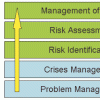Business Transformation Requires Transformational Leaders
Leadership and teaming skills are front and center in times of rapid change. Meet today’s constant disruption head on with expert guidance in leadership, business strategy, transformation, and innovation. Whether the disruption du jour is a digitally-driven upending of traditional business models, the pandemic-driven end to business as usual, or the change-driven challenge of staffing that meets your transformation plans—you’ll be prepared with cutting edge techniques and expert knowledge that enable strategic leadership.
Recently Published
A client recently asked how to assess the effectiveness of their IT organization. We immediately responded: does the IT organization add value to the business? Of course that's the right question -- but exactly how does one go about getting the answer?
The other morning, over coffee, I was talking with several folks about the predicament that the big US automotive manufacturers General Motors and Ford now find themselves in. Simply put, GM and Ford are in trouble because sales of their SUVs, pickups, and other large vehicles have declined considerably. Some defined it as a forecasting problem. Others said it was faulty data analysis, and asked me why Ford and GM's BI folks failed to predict the shift in consumer sentiment to smaller, more gas economical cars.
Intelligent Video Systems Update
Back in 2003, I wrote about the use of intelligent video systems for adding automated, real-time threat detection, identification and alarming capabilities to closed circuit television cameras for security applications (See "Intelligent Video Surveillance for Security Applications," 30 September 2003). Since then, there have been a number of new developments regarding intelligent video systems.
A Pragmatic Approach to Implementing ITIL: Part I -- Getting Started
This Executive Update, the first in a series of two, provides an overview of the methodology and approach used to develop detailed business processes for managing an IT environment. A real-life case study using an approach for creating service management processes and subprocesses is presented, and the interfaces needed to support application development migration are identified. Finally, an example process model as well as process flows are included.
Risk Management for ERP Programs: A Holistic Approach
Enterprise resource planning (ERP) programs are notoriously prone to implementation difficulties. Many overrun their budgets, slip their schedules, disappoint their sponsors, or all of the above.
The frameworks, ideas, data, and guidelines in this issue of <em>CBR</em> will be helpful in your quest to evaluate and possibly implement a service-oriented architecture in your organization.
Best Practices in ERM
There is no single best practice that is appropriate for all areas of risk associated with IT. Each risk area has a number of practices that should be considered. In this Executive Update, I focus on the following three areas:
-
Business strategy risks
-
Compliance risks
-
Process risks
This survey investigated the extent to which organizations have adopted service oriented architecture and SOA best practices. Of the 78 responding organizations, 27% have more than 10,000 employees, 23% have between 1,000 and 10,000 employees, 28% have between 100 and 1,000 employees, and the remaining organizations have 100 or fewer employees.










